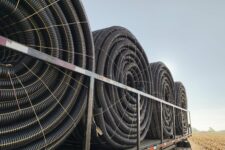Spend limited working capital to kick-start yield on poorly drained soils.
It was easy to spend money on drainage tile five years ago when profits were rolling in. What about now?
Turns out investing in tile may be an even smarter expense these days, as long as you’re installing it where it’s needed — and especially with weather extremes playing havoc on spring planting.
“Tiling is still the best ROI, even now with limited working capital,” says Lee Bunting, who farms and runs a tiling business in northern Illinois. “Last fall even with corn prices down around $3 and beans around $9, people were still investing in drainage. That just proves that the ag community realizes drainage is an important part of increasing production.
“With low grain prices, you have to keep generating bushels,” he adds.
One could argue that a combination of factors — weather, drainage, and seed technology — factored heavily in four consecutive above-trend or record-yielding corn and soybean years.
Benefits of drainage show up more clearly in years when farmers must work around spring weather hiccups. Case in point: Last year Bunting replanted several cornfields because of wet, cold weather in April and May, and still had “tremendous” yields.
“It’s because of drainage and good genetics,” he says. “We were wet until Fourth of July, and it turned off dry. The corn got roots into the ground, and we maintained the water level in the ground with tile. That makes a difference.”
Bunting has been farming with two brothers Don and Art since 1974. The drainage business makes up a third of their income.
Costs for tile installation vary based mainly on the availability of a nearby outlet. “You can probably get it tiled for $400 an acre at a minimum,” Bunting says. “If you have to find an outlet and run big mains, that’s where the higher costs come in.” Intensive tiling can cost $800 to $1,000 per acre, but that does not include the tax deduction.
Charles Brown, Iowa State University farm management Extension specialist, offers some estimated yield advantages. For tiling very poor to poorly drained soils, figure a 54-bushel-per-acre increase for corn and 18 bushels for soybeans. If land is somewhat poorly drained, pencil in a 30-bushel yield increase for corn and 12 bushels for beans. On moderately well-drained to somewhat poorly drained soil, it’s a 12-bushel increase for corn and 5 bushels for beans. These are estimates; every outcome will vary, of course.
Drained soils have other benefits, too. “Where we have tile on our own farm the ground is more porous and you get a better, more even stand of corn or beans,” Bunting says. “You’re maintaining your underground water table. And with today’s better genetics, you have better drought resistance and better rooting. It all leads to better yields and quicker ROI.”
The tile plow has been the major change in the drainage business, Bunting says. “When we started, it was clay or cement tile. We had very little plastic tile at the time. Now, GPS — automatic guidance —has really revolutionized tiling. You get a lot more done; it’s quicker and more efficient.”
Published by Mike Wilson | Mar 29, 2018 | Farm Futures


